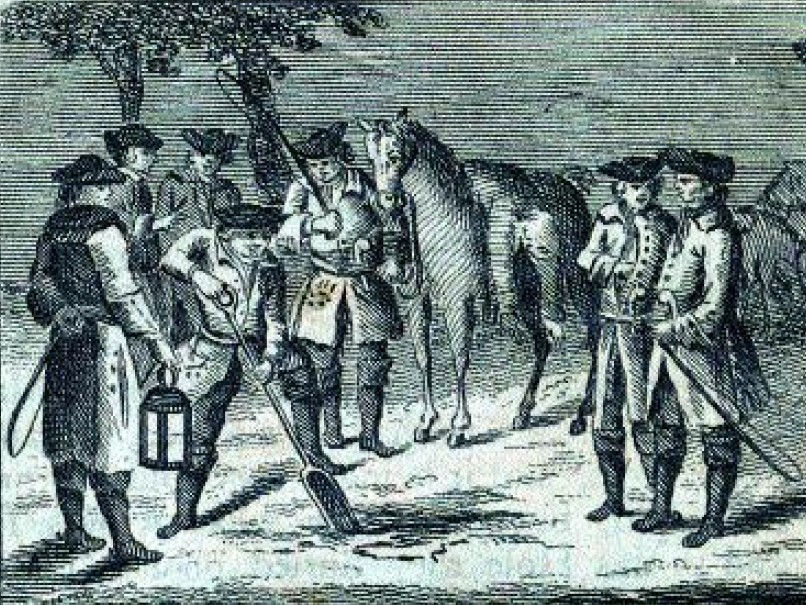In my book, "The Smuggler's Daughter", Adam Mason is sent to Sussex to discover a ruthless gang of smugglers. The job is dangerous. Smugglers were hard men, who held human life cheap and they were unforgiving of anyone who threatened their success.
Of all the smuggling gangs that frequented the south east coast of England in real life at that time, none were more infamous, or more feared, than the Hawkhurst Gang. Nearly 250 years after their downfall, this gang is still spoken of with awe and fear.
They didn't operate for very long, considering their lasting notoriety. They were first mentioned in 1735, and they were broken up and defeated just 14 years later, in 1749. To the authorities, and those who earned their ire, though, those 14 years must have seemed interminable.


The gang was named after the village of Hawkhurst, which lies between Tunbridge Wells in Kent and Hastings in Sussex. It was ideally placed for those transporting goods from the sea to the buyers. They met to plan their activities in the Oak and Ivy pub in Hawkhurst, but were also known to frequent the Mermaid Inn in Rye.
Here, they sat with their loaded weapons on the table, ready for use.
They were known for their boldness and their viciousness. There is a road near Winchelsea, a village between Hastings and Rye, which is called Dumb Woman's Lane. The author and journalist, Alex Preston, asserts in his book, “Winchelsea,” which is based on the Hawkhurst Gang and their exploits, that the street was named after a local publican's wife who had her tongue cut out by the gang because she had informed on them.
When they caused a ruckus in the streets of Rye one evening, they noticed a young man, James Marshall. Marshall showed too much interest in them for their liking, so they took him away. He was never seen again.

They suspected a farm labourer, Richard Hawkins, of stealing two bags of tea. They interrogated him, torturing him until he died before weighting his body with rocks and throwing him into a lake at Parham Park.
Their victims were not just local inhabitants who had no way of fighting back. In 1740, a riding officer, Thomas Carswell, led a party of dragoons, and they found 750g of smuggled tea in a barn in Etchingham. They seized it as contraband and took it to Hastings. On the way, about thirty members of the gang attacked them, killed Carswell and captured the soldiers, before taking back their tea.
The authorities, who had done little about the attacks on citizens, were not about to turn a blind eye when the violence was aimed at themselves. Soon after this crime, one of the smugglers, George Chapman, was executed for his part in it.
Their most audacious raid came in October 1747. The Government had seized a great deal of contraband, including 3,360lbs of tea, 39 casks of brandy and rum, and some coffee, from the smuggling ship, “Three Brothers.” Worth about £500 then, the haul would be valued at about £93,000 today. Understandably, when it was worth such an amount, the smugglers wanted it back.

The contraband was stored in the Custom House in Poole, Dorset. Members of the Hawkhurst gang, including the gang leaders, Thomas Kingsmill and William Fairhall, joined with about thirty other men from various other gangs and journeyed to Poole, reaching the custom house at eleven o’clock at night. They quickly learned the Custom House was protected by the guns of a naval sloop, but the smugglers, seafarers all, realised that as the tide changed, the gunners from the ship would not have sight of the Custom House, and would be unable to help.
They waited until two in the morning, then broke in. They managed to make off with the tea, although they had to leave everything else behind, because they just couldn't carry it. The raid was a complete success, and the gang faced no opposition at all. The humiliated Customs Service offered a reward of £500 for their capture.
With such a life changing amount on offer, it was inevitable that someone would identify one of the smugglers eventually, although it is thought that the eventual witness, Daniel Chater, may not have intended to betray them. He had been given a bag of tea by a smuggler known as Diamond, and word of this got out, somehow. Chater was compelled to testify.
He travelled with a Customs Officer to Dorset, where he was to give evidence. However, the men got lost on the way, and stopped at a pub in Hampshire. The landlady was suspicious of them, and sent for the smugglers. They managed to get Chater and the customs man passing out drunk, then found their papers, detailing their mission. The men were tied and taken to Rake, near Chichester, where the customs man was buried alive.
Chater himself was held captive for several days before the gang threw him into a well and dropped stones on him until he, too, died.
The viciousness of their tactics made them very successful, but it also led to their downfall. More of that next time.
The Smuggler's Daughter is published by The Wild Rose Press and can be found here.


Comments